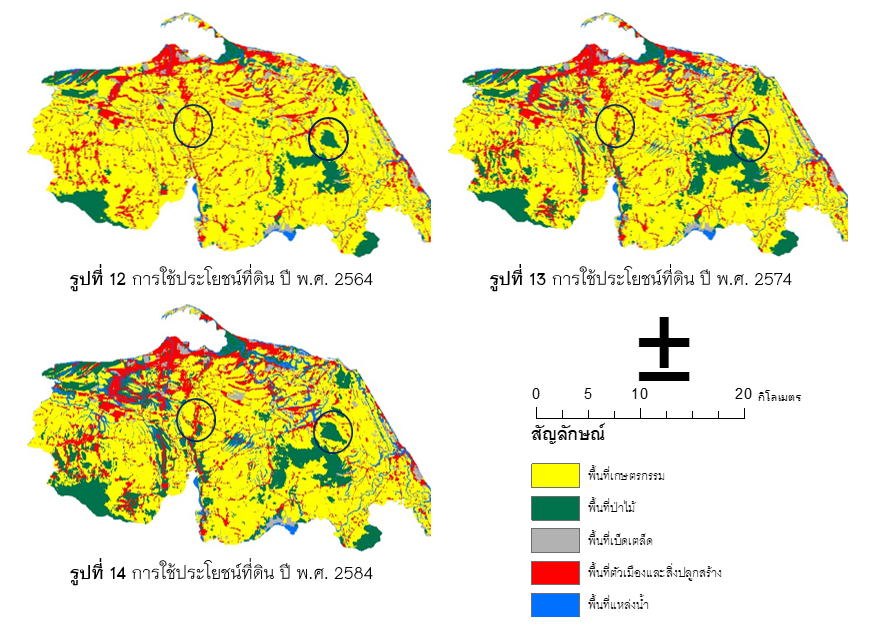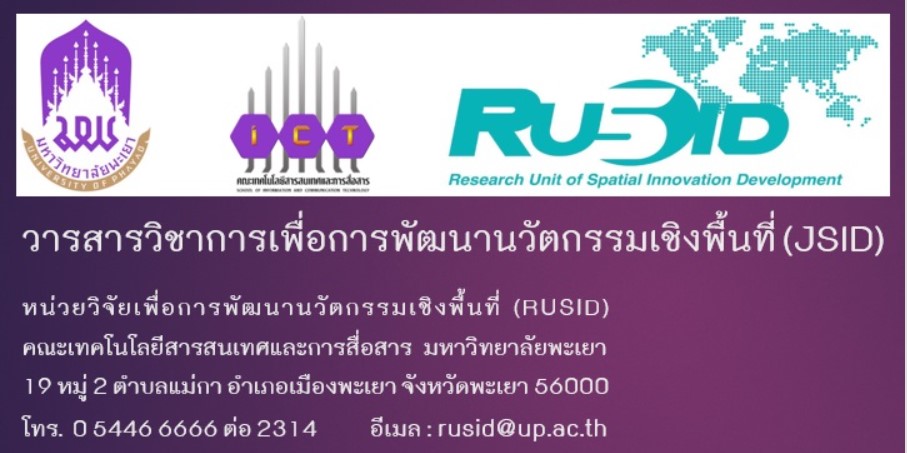การจำลองและคาดการณ์การใช้ประโยชน์ที่ดินโดยใช้แบบจำลองคลูมอนโดในจังหวัดปัตตานี
คำสำคัญ:
การใช้ประโยชน์ที่ดิน, แบบจำลอง, คลูมอนโด, ปัตตานีบทคัดย่อ
การคาดการณ์การใช้ประโยชน์ที่ดินและการเปลี่ยนแปลงการใช้ประโยชน์ที่ดินจังหวัดปัตตานี ในการศึกษาครั้งนี้มีจุดประสงค์ (1) เพื่อคาดการณ์การใช้ประโยชน์ที่ดิน ปี พ.ศ. 2561 และประเมินความถูกต้องของแบบจำลองCLUMondo (2) เพื่อคาดการณ์การใช้ประโยชน์ที่ดิน ปี พ.ศ. 2564 , พ.ศ. 2574 และ พ.ศ. 2584 (3) เพื่อศึกษาการเปลี่ยนแปลงการใช้ประโยชน์ที่ดิน ปี พ.ศ. 2561 ถึง พ.ศ. 2584 โดยมีวิธีการนำการใช้ประโยชน์ที่ดิน ปี พ.ศ. 2550 และ พ.ศ. 2559 คาดการณ์การใช้ประโยชน์ที่ดิน ปี พ.ศ. 2561 และประเมินความถูกต้องของแบบจำลอง โดยใช้การใช้ประโยชน์ที่ดิน ปี พ.ศ. 2561 จากกรมพัฒนาที่ดินมาตรวจสอบ ผลลัพธ์ความถูกต้องโดยรวม เท่ากับ 0.98 และค่าแคปป้า เท่ากับ 0.97 คาดการณ์การใช้ประโยชน์ที่ดิน ปี พ.ศ. 2564 , พ.ศ. 2574 และ พ.ศ. 2584 สรุปผลได้ว่า การคาดการณ์การใช้ประโยชน์ที่ดิน ปี พ.ศ. 2561 พบว่า เกษตรกรรม , ตัวเมือง และ ป่าไม้ มีพื้นที่ 1,451.26 , 251.58 และ 142.12 ตารางกิโลเมตร ตามลำดับ การคาดการณ์การใช้ประโยชน์ที่ดิน ปี พ.ศ. 2564 , พ.ศ. 2574 และ พ.ศ. 2584 พบว่า ปี พ.ศ. 2564 เกษตรกรรม มีพื้นที่ลดลงจาก ปี พ.ศ. 2561 38.66 ตารางกิโลเมตร ป่าไม้ เบ็ดเตล็ด มีพื้นที่เพิ่มขึ้นจาก ปี พ.ศ. 2561 21.50 , 0.34 ตารางกิโลเมตร ตามลำดับ ปี พ.ศ. 2574 เกษตรกรรม มีพื้นที่ลดลง 133.66 ตารางกิโลเมตร ส่วนป่าไม้ เบ็ดเตล็ด มีพื้นที่เพิ่มขึ้น 78.60 , 0.10 ตารางกิโลเมตร ตามลำดับ ปี พ.ศ. 2584 เกษตรกรรม มีพื้นที่ลดลง 132.47 ตารางกิโลเมตร ส่วนป่าไม้ เบ็ดเตล็ด มีพื้นที่เพิ่มขึ้น 76.67 , 1.52 ตารางกิโลเมตร ตามลำดับ จึงทำให้สามารถทราบการเปลี่ยนแปลงหรือแนวโน้มที่จะเกิดขึ้นในอนาคต และสามารถจัดสรรการใช้ประโยชน์ที่ดินให้เป็นไปตามที่เหมาะสม
เอกสารอ้างอิง
คณะกรรมการบริหารงานจังหวัดแบบบูรณาการจังหวัดปัตตานี. (2558). แผนพัฒนาจังหวัดปัตตานี พ.ศ.2557-2560 ฉบับทบทวน (รอบปี พ.ศ.2560). ปัตตานี: สำนักงานจังหวัดปัตตานี.
ชุติพงศ์ ร่มสนธิ์. (2551). การคาดการณ์การเปลี่ยนแปลงการใช้ที่ดิน และสิ่งปกคลุมดิน โดยใช้แบบจำลอง CA-MARKOV บริเวณลุ่มน้ำแม่แจ่ม จังหวัดเชียงใหม่ (วิทยาศาสตรมหาบัณฑิต). สาขาการจัดการลุมน้ำและสิ่งแวดลอม, มหาวิทยาลัยเกษตรศาสตร์, กรุงเทพฯ.
ธณัชชัย วิยานนท์, ชูพันธุ์ ชมภูจันทร์, และ วิษุวัฒก์ แต้สมบัติ. (2563). การคาดการณ์การใช้ประโยชน์ที่ดินในลุ่มน้ำสาขาย่อยห้วยผาก จังหวัดเพชรบุรี ด้วยแบบจำลอง CA-Markov. การประชุมวิชาการสมาคมวิศวกรรมเกษตรแห่งประเทศไทย ระดับนานาชาติ ครั้งที่ 13 และระดับชาติ ครั้งที่ 21 (น. 250-257). ณ โรงแรมแคนทารี โคราช, นครราชสีมา.
นิติ เอี่ยมชื่น, วันณัชชา เทพวงศ์. (2563). การพยากรณ์การใช้ประโยชน์ที่ดินด้วยแบบจำลอง CLUmondo กรณีศึกษา อำเภอเมือง จังหวัดเชียงใหม่. วารสารวิชาการเพื่อการพัฒนานวัตกรรมเชิงพื้นที่, 1(2), 1-13.
ยงยุทธ ไตรสุรัตน์. (2558). The CLUMondo Land Use Change Model คู่มือการใช้โปรแกรมและแบบฝึกหัด. คณะวนศาสตร์, มหาวิทยาลัยเกษตรศาสตร์, กรุงเทพฯ, 61น.
วันณัชชา เทพวงศ์, ธิดาภัทร อนุชาญ และ นิติ เอี่ยมชื่น. (2565). การเปรียบเทียบแบบจำลอง CLUMondo และแบบจำลอง CA-Logistic ในการพยากรณ์การใช้ประโยชน์ที่ดินในเขตเมือง กรณีศึกษา อำเภอเมืองเชียงราย จังหวัดเชียงราย. วารสารวิทยาศาสตร์บูรพา, 27(3), 16187-1634.
วีระภาส คุณรัตนสิริ. (2563). การศึกษาเปรียบเทียบแบบจำลอง CA-Markov และแบบจำลอง CLUE-S เพื่อคาดการณ์การเปลี่ยนแปลงการใช้ประโยชน์ที่ดินพื้นที่ป่าสงวนแห่งชาติ จังหวัดน่าน. วารสารวิทยาศาสตร์ประยุกต์, 19(2), 78-100.
วุฒิพงษ์ นิลจันทร์. (2561). การเปรียบเทียบการคาดการณ์การใช้ประโยชน์ที่ดินและสิ่งปกคลุมดินโดยใช้ แบบจำลอง CA-MARKOV และ แบบจำลอง LAND CHANGE MODELER กรณีศึกษาจังหวัดพะเยา (ปริญญานิพนธ์ระดับปริญญาตรี). สาขาวิชาภูมิสารสนเทศศาสตร์, มหาวิทยาลัยพะเยา, พะเยา.
ส่วนบริหารและพัฒนาเทคโนโลยีการทะเบียนสำนักบริหารการทะเบียน. (2562). สถิติจำนวนประชากรและบ้าน. สืบค้นจาก https://stat.bora.dopa.go.th/stat/statnew/statINTERNET/fbclid=IwAR1XLPQgWlRdEEQ0yK3MO5KxrM8GKCpuqF9elrKC1OTtV7pV2sXZkSADtzo#/
Aynew Y. (2008). Rainfall – Runoff modelling for sustainable water resources management (Master of Science Thesis). School of Graduate Studies, Ethiopia Addis Ababa University, Ethiopia.
Cammerer, H., Thieken, A. H., & Verburg, P. H. (2013). Spatio-temporal dynamics in the flood exposure due to land use changes in the Alpine Lech Valley in Tyrol (Austria). Natural hazards, 68, 1243-1270.
Castella, J. C., & Verburg, P. H. (2007). Combination of process-oriented and pattern-oriented models of land-use change in a mountain area of Vietnam. Ecological modelling, 202(3-4), 410-420.
Fitzpatrick-Lins, K. (1981). Comparison of sampling procedures and data analysis for a land-use and land-cover map. Photogrammetric Engineering and Remote Sensing, 47(3), 343-351.
Fleiss, J. L., Levin, B., & Paik, M. C. (2013). Statistical methods for rates and proportions. john wiley & sons.
Gao, P., Gao, Y., Zhang, X., Ye, S., & Song, C. (2022). CLUMondo v2. 0: Improved model by adaptive determination of conversion orders for simulating land system changes with many-to-many demand-supply relationships. Geoscientific Model Development Discussions, 1-28.
Githui, F., Mutua, F., & Bauwens, W. (2009). Estimating the impacts of land-cover change on runoff using the soil and water assessment tool (SWAT): case study of Nzoia catchment, Kenya. Hydrological sciences journal, 54(5), 899-908.
Lin, Y. P., Verburg, P. H., Chang, C. R., Chen, H. Y., & Chen, M. H. (2009). Developing and comparing optimal and empirical land-use models for the development of an urbanized watershed forest in Taiwan. Landscape and Urban Planning, 92(3-4), 242-254.
Luo, G., Yin, C., Chen, X., Xu, W., & Lu, L. (2010). Combining system dynamic model and CLUE-S model to improve land use scenario analyses at regional scale: A case study of Sangong watershed in Xinjiang, China. Ecological Complexity, 7(2), 198-207.
Mehdi, B. B., Ludwig, R., & Lehner, B. (2012). Determining agricultural land use scenarios in a mesoscale Bavarian watershed for modelling future water quality. Advances in Geosciences, 31, 9-14.
Nassar, A. M., Harfuch, L., Bachion, L. C., & Moreira, M. R. (2011). Biofuels and land-use changes: searching for the top model. Interface Focus, 1(2), 224-232.
Oh, Y. G., Yoo, S. H., Lee, S. H., & Choi, J. Y. (2011). Prediction of paddy field change based on climate change scenarios using the CLUE model. Paddy and Water Environment, 9, 309-323.
Orekan, V. O. A. (2007). Implementation of the local land-use and land-cover change model CLUE-s for Central Benin by using socio-economic and remote sensing data (Doctoral dissertation). Universitäts-und Landesbibliothek Bonn, Germany.
Peng, Y., Xu, X., Yu, J., Liu, F., Qin, W., & Xia, Y. (2022). Spatial optimal allocation of land resources in Fengweihan, Kaishan, Laos. Natural Resources Conservation and Research, 5(1), 66-74.
Ruiqi, G. U. O., Bo, L. U., & Kailin, C. H. E. N. (2020). Dynamic simulation of multi-scenario land use change based on CLUMondo model: A case study of coastal cities in Guangxi. Remote Sensing for Natural Resources, 32(1), 176-183.
Schmalz, B., & Fohrer, N. (2009). Comparing model sensitivities of different landscapes using the ecohydrological SWAT model. Advances in Geosciences, 21, 91-98.
Trisurat, Y., Alkemade, R., & Verburg, P. H. (2010). Projecting land-use change and its consequences for biodiversity in Northern Thailand. Environmental Management, 45, 626-639.
Veldkamp, A., & Fresco, L. O. (1996). CLUE-CR: an integrated multi-scale model to simulate land use change scenarios in Costa Rica. Ecological modelling, 91(1-3), 231-248.
Verburg, P. H., Van de Steeg, J., & Schulp, N. (2005). Manual for the CLUE-Kenya application. Department of Environmental Sciences, Wageningen University, Wageningen, Netherlands, 54p.
Wang, H., Jin, Y., Hong, X., Tian, F., Wu, J., & Nie, X. (2022). Integrating IPAT and CLUMondo models to assess the impact of carbon peak on land use. Land, 11(4), 573.
Wu, J., Jin, X., Feng, Z., Chen, T., Wang, C., Feng, D., & Lv, J. (2021). Relationship of Ecosystem Services in the Beijing–Tianjin–Hebei Region Based on the Production Possibility Frontier. Land, 10(8), 881.
Yin, L., Dai, E., Xie, G., & Zhang, B. (2021). Effects of land-use intensity and land management policies on evolution of regional land system: A case study in the hengduan mountain region. Land, 10(5), 528.





